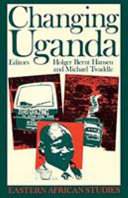
Changing Uganda : the dilemmas of structural adjustment & revolutionary change
By - / edited by Holger Bernt Hansen & Michael Twaddle.
Floor
-
Floor 4
ISBN 10 - 0821410059
ISBN 13 - 9780821410059
Book Status
-
1 Qnty Available with us.
Shelf No
-
5
Call Number
-
967.61 CHA
Physical Description
-
xi, 403 p. : ill., maps ; 23 cm.
Notes
-
Includes bibliographical references (p. 379-386) and index.